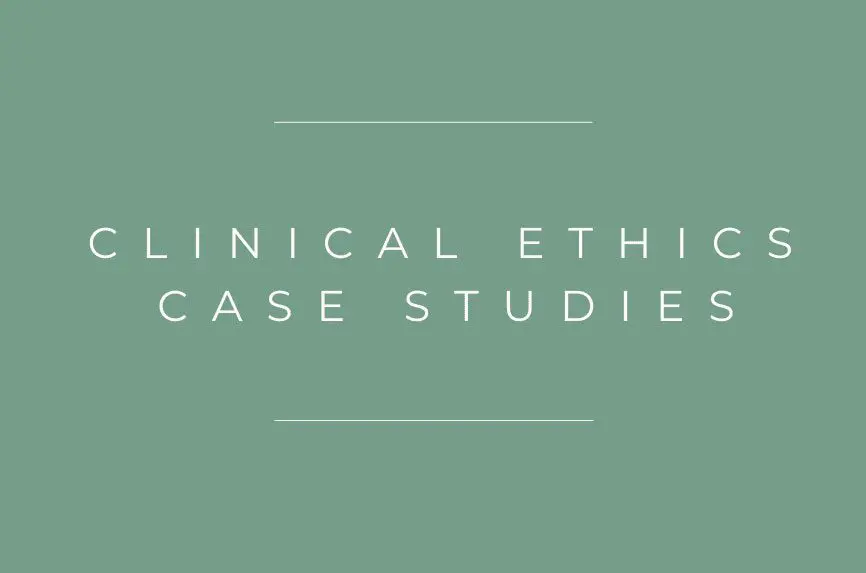Bioethics Forum Essay
Should an Incarcerated Patient Get an Advanced Heart Therapy?
Case Narrative
W is a 32-year-old man with heart failure. Prior to diagnosis he was relatively healthy and physically fit. A trial of medication was not effective. Some members of W’s care team recommended that he be evaluated for an advanced heart therapy—a heart transplant or ventricular assist device (VAD)–but other members of the team questioned whether this would be appropriate, given that W had been incarcerated in a state facility for more than 10 years without the possibility of parole. The ethics team at the hospital where W was receiving treatment was asked to provide guidance.
This dilemma reflected a longstanding public debate about whether incarcerated individuals should be eligible to receive limited resources and the challenges of providing medical care in the carceral setting. The debate traces back at least to 2002, when a 31-year-old incarcerated man in California received a heart transplant, sparking significant disagreement in medical communities and in the public about whether prisoners should be eligible to receive these scarce resources. United States law requires “adequate” medical care for incarcerated individuals, and the United Network for Organ Sharing recommends that incarceration not be an absolute contraindication to transplant consideration. Another important consideration is that the incarcerated population is disproportionally made up of marginalized groups that have historically not received equitable care; W is Black. As professionals committed to justice in health care, clinical ethicists do not consider “social worth,” including conviction history, in our evaluations of ethical questions about the provision of care.
Ethical Analysis and Process
The ethics team met separately with the medical team and with W. Each of these meetings had different goals.
While the medical team had previously cared for a few patients who had received advanced heart therapies and then been incarcerated, this was their first request to evaluate an incarcerated patient who had developed life-threatening cardiac disease. The team was committed to avoiding inappropriate social judgements, and requested an ethics consult as they weighed potential benefits and harms of transplant, VAD, or continuation of medical management, which would have extended W’s life for a short time. The ethicists created a safe space for the medical team to meet and explore their possible conscious and unconscious biases, invited the team to be honest about hidden assumptions of worth and deservingness, and raised questions about the appropriateness of the traditional psychosocial assessment model for this patient population.
The ethicists asked the medical team to carefully consider the details of prison life and medical care and invited an expert on care in carceral settings to provide information. Many jails and prisons do not have staff who can address medical needs following transplant or VAD placement. This could lead to a lengthy, possibly unnecessary, hospitalization of an incarcerated patient while appropriate placement is sought, straining the hospital’s resources. Nonmedical needs, including access to good nutrition and psychosocial support, may go unmet in the carceral setting. Chronic medical issues related to transplants or VAD could lead to an incarcerated patient being perceived by peers as vulnerable or weak, which could put the patient at risk. The medical team’s inability to directly contact the patient and barriers to its ability to reach infirmary and other relevant staff directly for follow-up, as well as delays in accessing acute care in case of emergency, could be life-threatening to the patient. Conversely, an incarcerated person may have better social support than some people living in community settings. The infirmary in carceral settings guarantees a consistent power source for a VAD. The infirmary is also a protective environment that may help reduce the risk of infection (relative to the general population) and support medication adherence.
The medical team also raised questions about the ultimate benefit of advanced therapy for W given his already constrained lifestyle. The ethicists encouraged the medical team to avoid assumptions about W’s current or future quality of life, as many people who experience significant limitations regardless of the cause have meaningful lives. We also stressed the importance of eliciting W’s own values. When we explored these with W, his concerns centered around suffering due to insufficient medical care at his facility and no longer being able to engage in the activities that he relied on for health and mental well-being, like exercise. He found the thought of new limitations on top of existing restrictions to be almost unimaginable and questioned his ability to tolerate them. At the same time, he felt that his family would want him to make this effort, and he wanted more time with them. We ensured that W felt empowered to ask questions about the risks and benefits of advanced therapy and to exercise agency in treatment decisions.
The evaluation required exponentially more time from the medical team than would have been the case with a patient in the general community. Prison leadership had limited availability to work with the medical team to evaluate whether the prison’s medical resources would be sufficient to meet W’s ongoing needs; access to prison staff for VAD training had also been limited. Similar challenges were anticipated with ongoing monitoring and care, and medical team members shared concerns that the time and resources required to care for W might limit their ability to care for other patients. While agreeing that this should not be a reason to reject the possibility of advanced therapies for W, the ethicists acknowledged it as a potentially limiting factor that might need further consideration in settings of increased demand.
The Decision
A heart transplant was determined to be inappropriate because of the risk of harm, which was heightened by the inability to provide expedited transport to the hospital if complications occurred and the limited medical care in the prison. These issues compromised the benefit of a scarce resource. However, the ethics and medical teams agreed that the benefit of a VAD to W would outweigh its risks, even while requiring greater resource investment from the follow-up team than would be required for patients who are not incarcerated. W’s concerns about his quality of life with a VAD were outweighed by his wish to live, and he chose to accept VAD when it was offered. W underwent successful, uncomplicated VAD placement, and returned to his correctional facility. Follow- up is ongoing.
Lingering Questions
We do not have doubts about the decision to offer an advanced therapy to W, but this case raises a question that requires us to think beyond the boundaries of our institution: What is the scope of responsibility of any individual heart failure program to ensure equitable treatment and work to address structural inequities when so many factors, like access to care and other social determinants, are out of our control? While, in contrast to donor organs, advanced therapies like VADs may not be scarce resources, hospital care teams are. Is it appropriate for more of these clinical resources to be directed toward addressing inequities if there is a counter-effect of being able to serve fewer patients overall?
As the incarcerated population ages, the need for complex medical treatment from many medical specialties is expected to increase (for heart failure, metastatic cancers, and neurological disorders, to name just a few). To help inform future decisions in similar situations, it will be helpful to study not only outcomes, but also anticipated versus actual challenges in receiving appropriate medical care in jails and prisons, as well per-patient follow-up time from hospital teams and any impact that this has on the overall number of patients able to access advanced therapies. This information may help us assess the “cost” of a commitment to equity in the context of technological advances in treatment options. It may also help frame decision-making processes as an increasing number of under-resourced persons in the community (impoverished elderly, unhoused people, asylum seekers) seek care in our health care institutions.
Sarah J. Russe, DBe, MA, HEC-C, is the program manager for the clinical consult service at Northwestern Memorial Hospital in Chicago.
M. Jeanne Wirpsa, MA, BCC, HEC-C, is the program director for medical ethics at Northwestern Memorial Hospital. LinkedIn https://www.linkedin.com/in/m-jeanne-wirpsa-ma-bcc-hec-c-5807561a3/
Series Editors’ Comment: Adequate, Equitable, or Feasible?
Deciding whether a patient should receive an advanced heart therapy begins with assessing medical need and benefit, but it must also consider the social context and, therefore, norms and values. Is the therapy adequate? Equitable? Feasible?
Advanced heart therapies can rely heavily on social support and access to care outside the hospital, as well as economic and other resources. In a society where these resources are not accessible to every patient, the appropriateness of therapies can come to be judged not just on the patient’s medical status but also on the inaccessibility of necessary supportive care. When system-level approaches are applied to individual patients–such as criteria for candidacy for organ transplantation–the injustices of disproportionate barriers to health care become readily apparent. An ethics consultation is unlikely to have the power to resolve broader injustices, but it can unpack how injustices are operating for a particular patient such as W and offer recommendations based on W’s specific context and values.
Any ethics consultation in a carceral setting can ultimately feel inadequate or even unjust. This is because the ethics consultants must work in a space between (a) perpetuating systemic medical norms that obstruct access for patients like W and (b) advocating for systemic change to prevent such inequities. Though perhaps morally unsatisfactory and distressing, the ethics consultants must question, but also operate within, the boundaries of what is possible for incarcerated patients. In this case, a recommendation for VAD placement was justified based on respect for the patient’s choices, benefit, prevention of harm, and equitable care. But the clinical ethics consultants must also be careful to categorize any ethical failures. For example, was it an ethical failure to not list W for a heart transplant because, even though it might have been medically justified, getting that medical benefit was not feasible in the carceral setting? Ultimately, even when it is impossible to overcome barriers to accessing beneficial medical care, it can still be important to track such barriers in order to make institutional and societal improvements to address patients’ needs equitably and respectfully.
The ethicists in this case had the institutional support needed to explore W’s context and values, even though their process required more resources than are typically devoted to patients living in the community. Ethicists in other institutions may not find similar support. What the ethicists achieved for W would not be considered feasible everywhere, and we should be asking: why not?
– Gina Campelia and Laura Guidry-Grimes
Learn more about the series, Clinical Ethics Case Studies for Hastings Bioethics Forum.
Attention clinical ethicists: learn how to contribute to the series.














Denying people medical care because they are incarcerated is unethical. Incarcerated people because of assumed mental intent is under scrutiny. There is no mental, only physical. The ethics of retribution is questionable.
All and all considered, for equitable treatment of a patient such as W the potential for a advanced therapy should not be rejected. To me, as a physician, this means that one should not factor into the decision the social value of a life. What has not been considered here, is that this is a young man and, even though he may be incarcerated for a more prolonged time, there is an opportunity for useful life outside if all means of therapy are not, at least, offered. I do understand well the risks and potential durability of cardiac transplantation, however, there are many cases of young individuals who have survived in a very long term with relatively few complications. The durability of immune suppression is one factor not considered here. At this time, immunosuppression rarely leads to tolerance. What was not discussed are the potential complications from a VAD. So, more and broader discussion of what after her is released some years from that time would be the patient’s options and plans…
I keep reading about incarcerated people getting denied ordinary treatment that would clearly benefit them. It seems to me the focus should be on this, rather than advanced, expensive therapies that might not provide any benefit.
Would it be ethically appropriate to also consider the reason of incarceration? I believe that minority communities, especially Latinx and Black ones, have been inappropriately incarcerated for decades, so there are individuals in jail for issues like petty crimes or possession of now-legal marijuana, etc.
I am curious about the ethical implications of providing advanced, expensive therapies to someone who is wrongfully in jail versus the provision of care for a mass-murderer or rapist.
I agree with Dr. Klein. The pros and cons of VAD implantation were not discussed. I believe that heart transplantation should have been explored. Medication adherence, drug levels, and standard precautions could have easily been maintained by the carceral health team.
As a healthcare professional, I believe our primary responsibility in cases like this is to focus on the medical needs of the patient, regardless of their incarceration or social status. I recognize that nonmedical individuals might see this issue differently, but healthcare providers should base their decisions on the principles of justice, beneficence, nonmaleficence, and autonomy. Whether the treatment involves medication, a cardiac device, or a heart transplant, the fact that a patient is incarcerated should not influence our judgment. We should prioritize fair and equal care for all patients.
W’s case highlights the tension between practical challenges and the commitment to providing fair care. While incarceration limits certain freedoms, it should not limit access to necessary medical treatment. The healthcare disparities that disproportionately affect incarcerated individuals, especially those from marginalized communities, should motivate us to ensure fair and unbiased access to therapies like VADs or heart transplants—not be used as a reason to deny care.
W’s case also reveals real challenges, such as ensuring adequate follow-up care within a prison setting. These challenges need to be acknowledged, but they should not prevent us from fulfilling our ethical duty to treat all patients fairly. Resource allocation problems should not be allowed to perpetuate existing healthcare inequalities.
As someone who has been involved in the organ donation process, I understand the importance of ensuring recipients can adhere to post-transplant regimens. While concerns about compliance and resource allocation in prison settings are justified, introducing moral judgments about an individual’s “deservingness” based on their incarceration is ethically dangerous. These decisions should be grounded in medical need, not societal judgments.
Some argue that the severity of an incarcerated person’s crime should influence organ allocation due to the limited supply of donor organs. However, this raises questions about ‘deservingness’ and whether criminal history should affect access to care, which could challenge the principles of fairness and justice in healthcare.
Looking ahead, xenotransplantation—using animal organs for human transplants—brings new ethical questions. While it could help solve the shortage of organs, it could also create the same biases we see with organ allocation for incarcerated people. I’m curious to see how xenotransplantation might affect this ethical situation, and it’s important to make sure these potential new treatments are shared fairly and don’t exacerbate existing healthcare disparities.
The ethical complexities surrounding healthcare for incarcerated individuals are undeniable, but our duty is to uphold the principles of justice, beneficence, nonmaleficence, and autonomy. By focusing on the medical needs of each patient and resisting societal biases, we can ensure our decisions are guided by fairness and ethical integrity. As innovations like xenotransplantation emerge, these principles will be key to ensuring fair and ethical healthcare for all.
W’s case is very interesting and highlights several issues in regard to the U.S. incarceration system. We have an aging incarcerated population that is disproportionately made up of vulnerable populations that are largely the result of targeted and unjust legislation and legal practices. In addition, we have an aging physician population that is starting to retire, further exacerbating the physician shortage. (1) It’s unfortunate that the heart transplant had a higher risk of harm due to transportation limitations and not that there was a strict medical benefit that supported VAD over a transplant. In an ideal scenario, this limitation shouldn’t even be a consideration when it comes to providing adequate medical care for incarcerated people. It calls to question whether W’s consent was true to his values or whether it was due to limitations outlined in the article (access to good nutrition and psychosocial support, the inability to directly contact the patient for follow-up, etc.) and he simply went with the choice that would get him care the fastest. As stated, the ethics evaluation took longer than expected due to a lack of support from the prison’s leadership and medical team, and W’s health may have started to become more dire as time went on.
Incarcerated patients are still patients and deserve to have access to the same treatment options as everyone else. The lack of medical resources in the U.S. is affecting everyone, but in an effort to triage, we need to focus on the most vulnerable populations first, and that includes incarcerated populations. The medical community has a dark history when it comes to using incarcerated people for medical research that is still being perpetuated by poor legislation and lack of oversight (see Say Their Names: Unclaimed Bodies and Untrustworthiness in Medical Science, also from the Hastings Bioethics Forum). The medical community has a duty to not only atone for past and current injustices but also to prioritize establishing systems in which incarcerated patients are able to have the opportunity to pursue treatment options that would best align with their values and intentions. W should have had the opportunity to explore the pros and cons of a heart transplant outside of the artificial limitations set by the incarceration system that is already stacked against him.
1. https://www.aamc.org/news/press-releases/new-aamc-report-shows-continuing-projected-physician-shortage